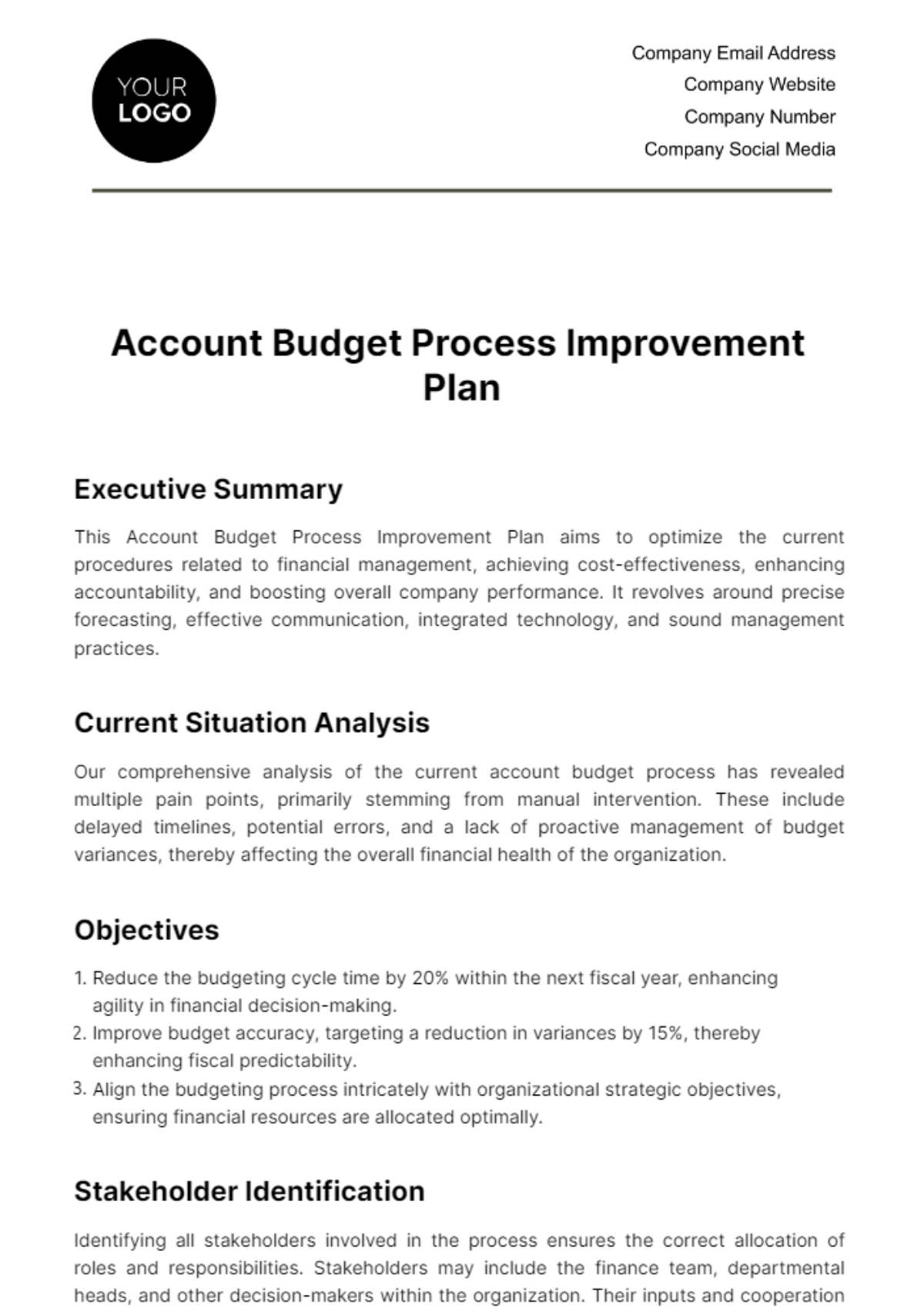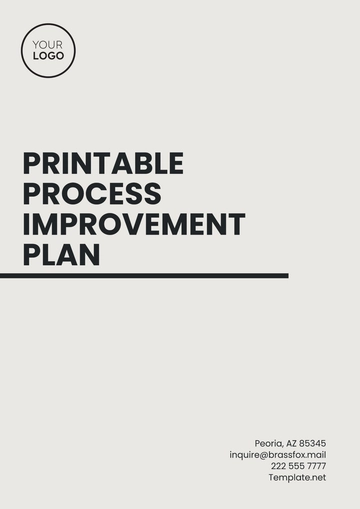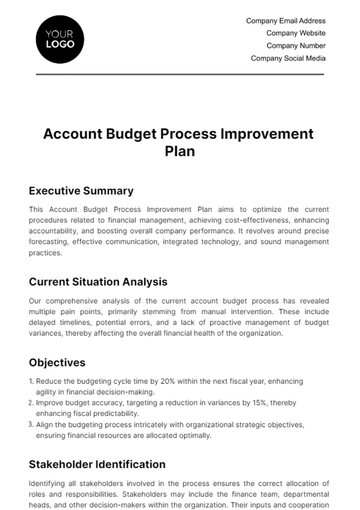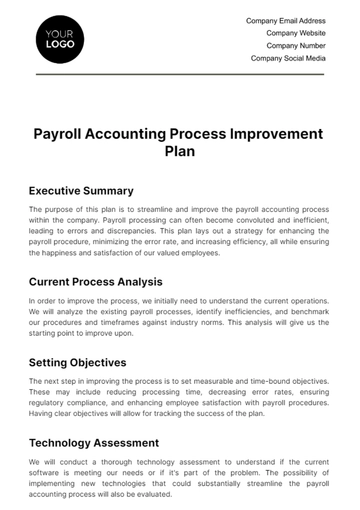Free Account Budget Process Improvement Plan

Executive Summary
This Account Budget Process Improvement Plan aims to optimize the current procedures related to financial management, achieving cost-effectiveness, enhancing accountability, and boosting overall company performance. It revolves around precise forecasting, effective communication, integrated technology, and sound management practices.
Current Situation Analysis
Our comprehensive analysis of the current account budget process has revealed multiple pain points, primarily stemming from manual intervention. These include delayed timelines, potential errors, and a lack of proactive management of budget variances, thereby affecting the overall financial health of the organization.
Objectives
Reduce the budgeting cycle time by 20% within the next fiscal year, enhancing agility in financial decision-making.
Improve budget accuracy, targeting a reduction in variances by 15%, thereby enhancing fiscal predictability.
Align the budgeting process intricately with organizational strategic objectives, ensuring financial resources are allocated optimally.
Stakeholder Identification
Identifying all stakeholders involved in the process ensures the correct allocation of roles and responsibilities. Stakeholders may include the finance team, departmental heads, and other decision-makers within the organization. Their inputs and cooperation are vital for a successful improvement plan.
Proposed Changes
Automation: Implement robust budgeting software to automate repetitive tasks, reducing manual errors and improving overall efficiency.
Streamlined Workflow: Redesign the workflow to minimize bottlenecks and ensure a smoother, more cohesive process.
Data Integration: Integrate financial and operational data, providing a holistic perspective for more informed budgetary decisions.
Implementation of Technology
Introduce cutting-edge budgeting software equipped with real-time collaboration features, advanced data visualization capabilities, and forecasting tools. This strategic technology integration empowers teams to make prompt, informed decisions, fostering financial resilience.
Training and Skill Development
Training will be conducted to ensure all stakeholders understand the new budgeting processes, software features and protocols. Learning these skills is crucial to ensure competent use of resources, leading to more accurate budget forecasts. Additionally, invest in targeted skill development programs focused on data analysis, equipping teams with the necessary competencies for navigating the enhanced budgeting process.
Timeline
Phase 1 (Months 1-3): Rigorous selection process for budgeting software and initiation of team training programs.
Phase 2 (Months 4-6): Implementation of automated workflow, ensuring a seamless transition.
Phase 3 (Months 7-12): Continuous monitoring, gathering feedback, and making necessary adjustments for ongoing optimization.
Performance Metrics
Budgeting Cycle Time: Measure the time taken for each budget cycle, aiming for a significant reduction.
Variance Analysis: Track and analyze the reduction in budget variances, enhancing fiscal predictability.
User Adoption Rate: Assess the speed and effectiveness of teams adapting to the new process, ensuring a smooth transition.
Feedback and Continuous Improvement
Institute a robust feedback loop through regular team meetings, surveys, and open forums. Encourage an organizational culture that actively seeks and implements suggestions for continuous process improvement, fostering a dynamic and adaptive financial management approach.
- 100% Customizable, free editor
- Access 1 Million+ Templates, photo’s & graphics
- Download or share as a template
- Click and replace photos, graphics, text, backgrounds
- Resize, crop, AI write & more
- Access advanced editor
Revolutionize financial planning with Template.net's Account Budget Process Improvement Plan Template. This solution is both editable and customizable, ensuring seamless integration into your unique workflow. This product is also editable in our AI Editor Tool, empowering your team to streamline processes, enhance accuracy, and achieve strategic financial objectives effortlessly. Get started today!
You may also like
- Finance Plan
- Construction Plan
- Sales Plan
- Development Plan
- Career Plan
- Budget Plan
- HR Plan
- Education Plan
- Transition Plan
- Work Plan
- Training Plan
- Communication Plan
- Operation Plan
- Health And Safety Plan
- Strategy Plan
- Professional Development Plan
- Advertising Plan
- Risk Management Plan
- Restaurant Plan
- School Plan
- Nursing Home Patient Care Plan
- Nursing Care Plan
- Plan Event
- Startup Plan
- Social Media Plan
- Staffing Plan
- Annual Plan
- Content Plan
- Payment Plan
- Implementation Plan
- Hotel Plan
- Workout Plan
- Accounting Plan
- Campaign Plan
- Essay Plan
- 30 60 90 Day Plan
- Research Plan
- Recruitment Plan
- 90 Day Plan
- Quarterly Plan
- Emergency Plan
- 5 Year Plan
- Gym Plan
- Personal Plan
- IT and Software Plan
- Treatment Plan
- Real Estate Plan
- Law Firm Plan
- Healthcare Plan
- Improvement Plan
- Media Plan
- 5 Year Business Plan
- Learning Plan
- Marketing Campaign Plan
- Travel Agency Plan
- Cleaning Services Plan
- Interior Design Plan
- Performance Plan
- PR Plan
- Birth Plan
- Life Plan
- SEO Plan
- Disaster Recovery Plan
- Continuity Plan
- Launch Plan
- Legal Plan
- Behavior Plan
- Performance Improvement Plan
- Salon Plan
- Security Plan
- Security Management Plan
- Employee Development Plan
- Quality Plan
- Service Improvement Plan
- Growth Plan
- Incident Response Plan
- Basketball Plan
- Emergency Action Plan
- Product Launch Plan
- Spa Plan
- Employee Training Plan
- Data Analysis Plan
- Employee Action Plan
- Territory Plan
- Audit Plan
- Classroom Plan
- Activity Plan
- Parenting Plan
- Care Plan
- Project Execution Plan
- Exercise Plan
- Internship Plan
- Software Development Plan
- Continuous Improvement Plan
- Leave Plan
- 90 Day Sales Plan
- Advertising Agency Plan
- Employee Transition Plan
- Smart Action Plan
- Workplace Safety Plan
- Behavior Change Plan
- Contingency Plan
- Continuity of Operations Plan
- Health Plan
- Quality Control Plan
- Self Plan
- Sports Development Plan
- Change Management Plan
- Ecommerce Plan
- Personal Financial Plan
- Process Improvement Plan
- 30-60-90 Day Sales Plan
- Crisis Management Plan
- Engagement Plan
- Execution Plan
- Pandemic Plan
- Quality Assurance Plan
- Service Continuity Plan
- Agile Project Plan
- Fundraising Plan
- Job Transition Plan
- Asset Maintenance Plan
- Maintenance Plan
- Software Test Plan
- Staff Training and Development Plan
- 3 Year Plan
- Brand Activation Plan
- Release Plan
- Resource Plan
- Risk Mitigation Plan
- Teacher Plan
- 30 60 90 Day Plan for New Manager
- Food Safety Plan
- Food Truck Plan
- Hiring Plan
- Quality Management Plan
- Wellness Plan
- Behavior Intervention Plan
- Bonus Plan
- Investment Plan
- Maternity Leave Plan
- Pandemic Response Plan
- Succession Planning
- Coaching Plan
- Configuration Management Plan
- Remote Work Plan
- Self Care Plan
- Teaching Plan
- 100-Day Plan
- HACCP Plan
- Student Plan
- Sustainability Plan
- 30 60 90 Day Plan for Interview
- Access Plan
- Site Specific Safety Plan


